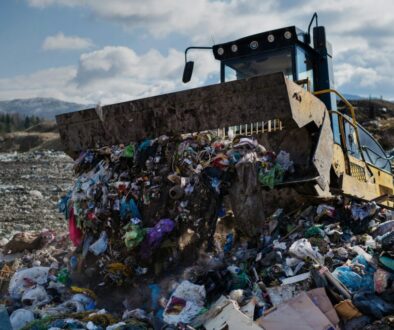Alarm sounded over effort to redefine PFAS chemicals
Listen to the audio version of this article (generated by AI).
Efforts by an international chemistry industry group to create a new, narrower definition for PFAS chemicals appear to be politically motivated, and could lead to weaker regulations of hazardous compounds, according to a group of international scientists.
The allegations, leveled by 20 scientists from nine countries, were published June 10 in the journal Environmental Science & Technology Letters.
“We are concerned that this effort is politically and/or economically, rather than scientifically, motivated,” the authors wrote. Narrowing the definition of per- and polyfluoroalkyl substances (PFAS) could “influence regulatory bodies and others to adopt less protective policies.”
The scientists say they are specifically worried that the International Union of Pure and Applied Chemistry (IUPAC), a federation of national chemistry societies and other groups representing chemists that calls itself “the world authority on digital standards in chemistry,” is working to redefine the PFAS class of chemicals to exclude fluorinated gases, trifluoroacetic acid (TFA) and fluorinated polymers used in a variety of industries for multiple purposes.
Such fluorinated gases are used in the creation of nuclear energy and the development of pharmaceuticals, while TFA is used to make pesticides and electronics and fluorinated polymers are used for semiconductors and lithium-ion batteries.
While industry groups argue that PFAS are critical to the renewable energy transition, the authors of the journal article state that “claims that certain PFASs are needed to fulfill public health, climate, and infrastructure goals are unrelated to the chemical definition of PFAS.”
The scientists say they support the current definition of PFAS chemicals used by the intergovernmental Organization for Economic Co-operation and Development (OECD), which was proposed in 2021.
The OECD defines PFAS as a class of fluorinated chemicals that contain at least one fully fluorinated methyl or methylene carbon atom. Similar definitions have been adopted by the European Union, at least 24 US states and by Congress through the National Defense Authorization Act.
The OECD definition “is solely based on intrinsic molecular features” and is “scientifically grounded, unambiguous and well suited to identify these chemicals,” the authors state in the journal article. “Justified exemptions can be made by policy makers for specific purposes without changing the general definition of what constitutes a PFAS.”
Health risks
PFAS are a class of thousands of humanmade chemicals used in a wide range of consumer products that can take hundreds or thousands of years to break down. PFAS are known to widely pollute the environment, with some linked to health problems that include cancers, high cholesterol, reproductive issues and liver damage.
Some health and environmental advocates push for regulating PFAS as a class, arguing that as one hazardous type of PFAS is phased out, industries simply switch to other PFAS chemicals that are also harmful, such as the company Chemours turning to GenX after the US banned cancer-linked perfluorooctanoic acid (PFOA) .
PFOA has been classified as carcinogenic to humans by an international cancer research group and linked to a variety of other health effects including reduced vaccine efficacy, but GenX also poses health risks. A 2018 assessment by the US Environmental Protection Agency (EPA) linked the compound – now used in place of PFOA to make many non-stick and water-resistant products – to kidney, blood, immune system and liver damage, as well as to elevated cancer risk.
IUPAC’s move to redefine PFAS comes as the Trump administration last month announced it plans to rescind limits for four types of PFAS in drinking water set during Biden’s presidency and to delay the timeline for water systems to comply with limits on two other PFAS.
Following an executive order freezing new federal regulations after President Trump took office in January, the US Environmental Protection Agency (EPA) withdrew draft guidelines for releases by PFAS manufacturers.
A defining debate
The IUPAC project, and reactions to it, highlight a debate among scientists and regulators over how PFAS should be defined, which comes as the European Union works to propose a sweeping ban on PFAS in consumer products expected to be introduced in 2026.
Some of the debate centers around the role that some chemicals the OECD defines as PFAS play in the clean energy transition, particularly fluoropolymers.
Members of the IUPAC working group tasked with redefining PFAS declined to respond to the concerns expressed in the statement or to comment on where the project currently stands.
The IUPAC, which calls itself “the world authority on chemical nomenclature,” states on the working group’s website, that it aims to establish a “specific and exhaustive” definition of PFAS that could be used for making policy decisions about the chemicals worldwide.
But the scientists penning the journal article say potential regulatory implications should not influence how PFAS are defined.
“Part of the reason why we wrote this statement is to prevent them from starting to mess things up by coming up with an alternative, presumably much more restrictive definition,” said Rainer Lohmann, director of a PFAS research center based at the University of Rhode Island.
In 2024, over 170 scientists with PFAS expertise signed a statement supporting the OECD definition and decrying definitions that exclude polymers and gases.
But others disagree and support the move for a new definition.
The OECD definition of PFAS is “overly broad” and could have “serious unintended consequences” since it includes certain pharmaceuticals, military materials and industrial technologies that are considered essential, said the American Chemistry Council (ACC), which said it is not involved in the IUPAC project.
“We need a definition that is both scientifically rigorous and policy-relevant—one that targets PFAS compounds of genuine concern while avoiding unnecessary restrictions and resource misallocation,” said the industry group.
IUPAC is not the first group or regulatory agency to develop a different way of defining PFAS than the OECD. The US EPA’s toxics office in 2023 began using a more flexible, “case-by-case” definition.
And, after an industry-led Indiana bill failed to pass this year, lawmakers introduced a similar bill there that proposes redefining PFAS “and requires the environmental rules board to use the definition in certain rules concerning industrial processes and research and development.”
Last month, Maine introduced its own bill that opponents say would reduce the number of PFAS chemicals covered by state laws that protect residents.
In a 2022 report, a panel of 12 chemicals experts from the US, Australia, Canada and Sweden agreed that the broad OECD definition “may be a useful starting place” but stated that the definition “needs to be refined for specific risk assessment goals.”
(Featured image by Karolina Grabowska via Unsplash.)




